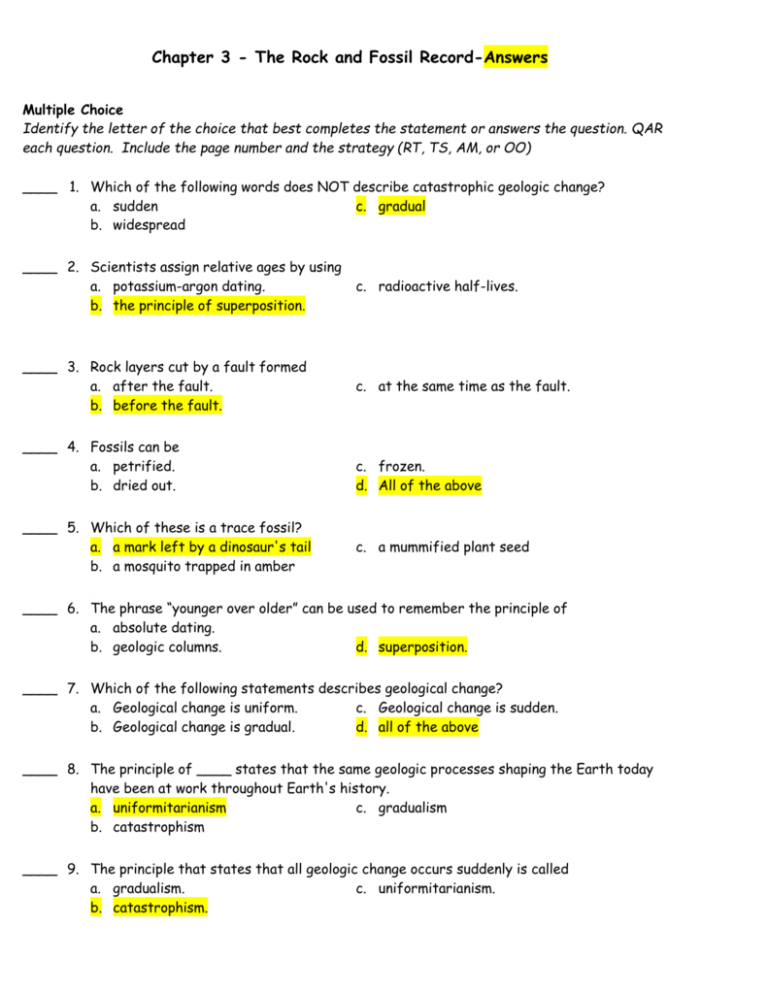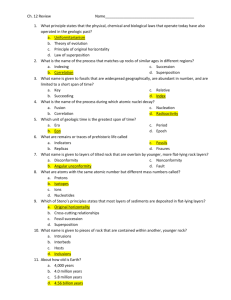Rock and Fossil Record Quiz Answers
advertisement

Chapter 3 - The Rock and Fossil Record-Answers Multiple Choice Identify the letter of the choice that best completes the statement or answers the question. QAR each question. Include the page number and the strategy (RT, TS, AM, or OO) ____ 1. Which of the following words does NOT describe catastrophic geologic change? a. sudden c. gradual b. widespread ____ 2. Scientists assign relative ages by using a. potassium-argon dating. b. the principle of superposition. c. radioactive half-lives. ____ 3. Rock layers cut by a fault formed a. after the fault. b. before the fault. c. at the same time as the fault. ____ 4. Fossils can be a. petrified. b. dried out. ____ 5. Which of these is a trace fossil? a. a mark left by a dinosaur's tail b. a mosquito trapped in amber c. frozen. d. All of the above c. a mummified plant seed \ ____ 6. The phrase “younger over older” can be used to remember the principle of a. absolute dating. b. geologic columns. d. superposition. ____ 7. Which of the following statements describes geological change? a. Geological change is uniform. c. Geological change is sudden. b. Geological change is gradual. d. all of the above ____ 8. The principle of ____ states that the same geologic processes shaping the Earth today have been at work throughout Earth's history. a. uniformitarianism c. gradualism b. catastrophism ____ 9. The principle that states that all geologic change occurs suddenly is called a. gradualism. c. uniformitarianism. b. catastrophism. ____ 10. Which theory does modern geology embrace? a. uniformitarianism c. gradualism b. catastrophism d. Both (a) and (b) ____ 11. Determining whether an object or event is older or younger than other objects or events is called a. absolute dating. c. relative dating. b. radiometric dating. ____ 12. Missing rock layers that create gaps in rock-layer sequences are called a. intrusions. c. unconformities. b. uniformities. ____ 13. The most common type of unconformity is called a(n) ____ a. disconformity. c. angular unconformity. b. nonconformity. ____ 14. Which of the following is a type of unconformity? a. disconformity c. angular unconformity b. nonconformity d. all of the above ____ 15. Which of the following is NOT a medium in which organisms fossilize? a. amber c. ocean water b. a glacier ____ 16. Which of the following organisms would be most likely to fossilize when buried in sediment? a. an organism with a soft body b. an organism with a hard shell c. an organism with weblike wing structures ____ 17. Organisms can be preserved by ____, a process in which minerals fill in pore spaces of an organism's tissues. a. mummification c. permineralization b. petrification ____ 18. ____ of an organism occurs when its tissues are completely replaced by minerals. a. Mummification c. Permineralization b. Petrification ____ 19. Whichof the following is the process by which trees fossilize? a. mummification c. permineralization b. petrification ____ 20. Insects can be preserved in ____, or hardened tree sap. a. amber c. ice b. tar ____ 21. Much of what we know about saber-toothed cats has come from animals that fossilized in a. rock. c. ice. b. tar. ____ 22. The remains of organisms that have died in dry places are preserved through a process known as a. mummification. c. permineralization. b. petrification. ____ 23. ____ fossil specimens are some of the best preserved of all fossils. a. Petrified c. Frozen b. Mummified ____ 24. Which of the following is a type of fossil that was NOT part of an organism? a. an insect in amber c. a trace fossil b. a mummified seed ____ 25. A ____ is a cavity in the ground or rock where a plant or animal was buried. a. mold c. track b. cast ____ 26. A ____ is an object created when sediment fills a mold and becomes rock. a. burrow c. coprolite b. cast ____ 27. A ____ remains when an animal's footprint fills with sediment that eventually turns to rock. a. burrow c. track b. cast ____ 28. A ____ is a fossilized shelter made by an animal that dug into the ground. a. coprolite b. cast d. burrow ____ 29. A ____ provides valuable information about the habits and diets of the animals that left it. a. coprolite c. track b. cast ____ 30. * A major difference between uniformitarianism and catastrophism is that they predicted a. where it is best to dig for fossils. b. whether civilizations could die out. c. significantly different ages of the Earth. ____ 31. * Suppose you organize photos for an album covering the time period from your birth until your second birthday. No dates have been written on the backs of the pictures, but you are able to put your photos in chronological order by looking at changes in your physical appearance. This is an example of a. absolute dating. c. relative dating. b. radiometric dating. ____ 32. * Which activity is an example of the superposition principle? a. hanging clothes in a closet c. choosing a book from the library b. tossing clothes into a laundry hamper Examine the illustration of rock layers below, and answer the questions that follow. ____ 33. * Which process disturbed these rock layers? a. tilting c. faulting b. folding ____ 34. * Which rock layers have the same relative age? a. 1 and 6 c. 3 and 7 b. 2 and 9 ____ 35. * Which of the following would most likely be used to determine the relative age of each rock layer? a. the geologic column c. faults b. superposition d. all of the above ____ 36. * A(n) ____ exists between horizontal rock layers and rock layers that are tilted or folded. a. disconformity c. angular unconformity b. nonconformity Examine the diagram of rock layers below, and answer the questions that follow. ____ 37. To determine the relative age of rock layers 1–3, you could use the principle of a. uniformitarianism. c. catastrophism. b. superposition. ____ 38. Rock layers 4–6 in have been disturbed by a. faulting c. folding. b. intrusion. ____ 39. * The boundary labeled A represents a type of unconformity that is often hard to see called a. a disconformity. c. an angular unconformity. b. a nonconformity. ____ 40. * What could you conclude if layer 3 contains reptile fossils and layer 5 contains amphibian fossils? a. Reptiles existed before amphibians. b. Amphibians existed before reptiles. c. Reptiles existed at the same time as amphibians. ____ 41. * Scientists often find rocks that contain marine fossils on mountaintops. What could such a discovery allow a scientist to conclude about how the position of the rocks changed over time? a. The position of the rock layers has not changed over time. b. Sediments were eroded from the ocean floor and redeposited here. c. These rocks were once below the surface of an ocean were and pushed up from below sea level. Short Answer 42. Why do Earth scientists need the principle of uniformitarianism in order to make predictions? 43. Consider a fault that cuts through all the layers of a rock-layer sequence. Is the fault older or younger than the layers? Explain. 44. Describe uniformitarianism. 45. Why do the frigid temperatures of Siberia and the sticky tar of the La Brea Tar Pits preserve fossils so well? 46. * Unlike other types of unconformities, disconformities are hard to recognize because all the layers are horizontal. How does a geologist know when he or she is looking at a disconformity? 47. * If you find rock layers containing fish fossils in a desert, what can you infer about that area of the desert? 48. * Would a shark tooth make a good index fossil? Why or why not? Examine the drawing below, and answer the following questions. 49. * Is intrusion A younger or older than layer X? Explain. 50. * What kind of unconformity is marked by 5? 51. * Is intrusion A younger or older than fault 10. Why? 52. ** The pictures below show geologic changes. However, the pictures are out of order. Label the pictures with the letters A, B, C, D, and E to show the correct geological sequence. The first picture has been labeled for you. Justify your ordering by explaining the changes that occurred between pictures. Chapter 3 - The Rock and Fossil Record Answer Section MULTIPLE CHOICE 1. C 2. B 3. B 4. D 5. A 6. D 7. D 8. A 9. B 10. D 11. C 12. C 13. A 14. D 15. C 16. B 17. C 18. B 19. C 20. A 21. B 22. A 23. C 24. C 25. A 26. B 27. C 28. D 29. A 30. C 31. C 32. B 33. C 34. B 35. D 36. C 37. B 38. C 39. A 40. B 41. C SHORT ANSWER 42. Scientists make predictions based on the past as well as the present. To make predictions, they must assume that geologic processes will be similar in the future. 43. The fault is younger than the layers. The layers had to be present for the fault to cut across them. 44. Uniformitarianism is the view that the Earth is shaped by gradual changes that are still occurring today. 45. Both environments retard the decay of an organism and help preserve it. 46. Disconformities represent a gap in the geologic column. If part of the column is missing from the layers, then the geologist has observed a disconformity. 47. Answers will vary. The desert was once an ocean, stream, or lake. 48. A shark tooth would not make a good index fossil because sharks have existed for more than 200 million years; index fossils are useful because the organisms existed for a short period of time. 49. Intrusion A is younger than layer X. 50. 5 marks an angular unconformity. 51. Intrusion A is younger than fault 10 because the intrusion is not disturbed by the fault. 52. Pictures are labeled from left to right: C, D, A, E, B. Folding has occurred between pictures A and B. By picture C, the folded layers have broken, and one side has dropped down. Picture D shows erosion of the rock layers exposed by movement along the fault surface. In picture E, sediments have been deposited on top of the eroded surface.







